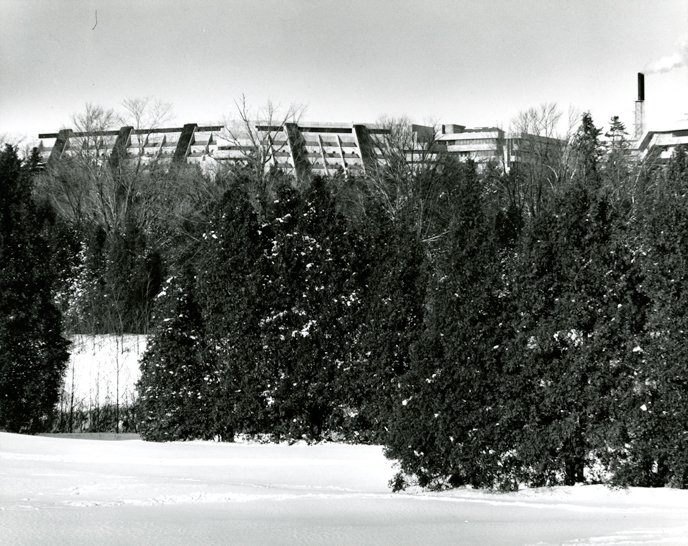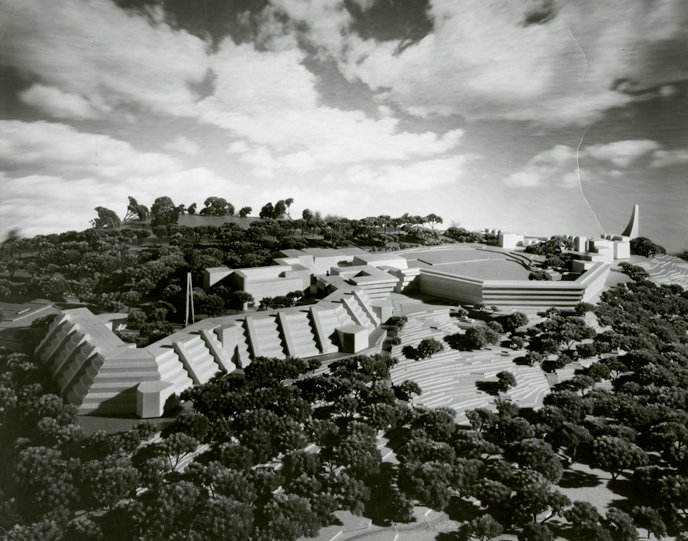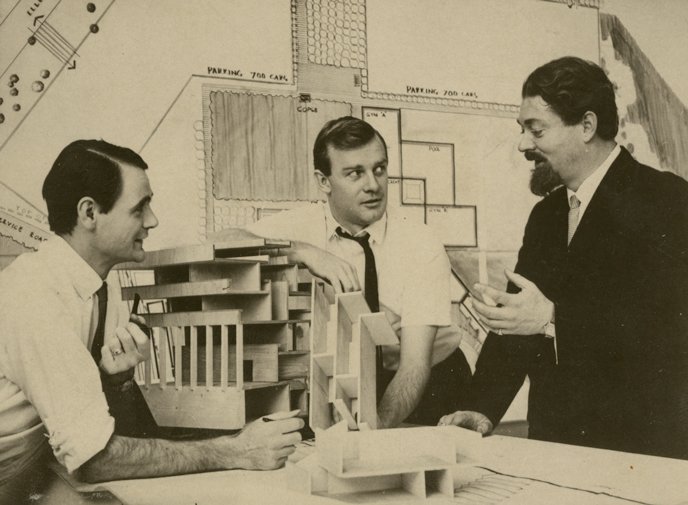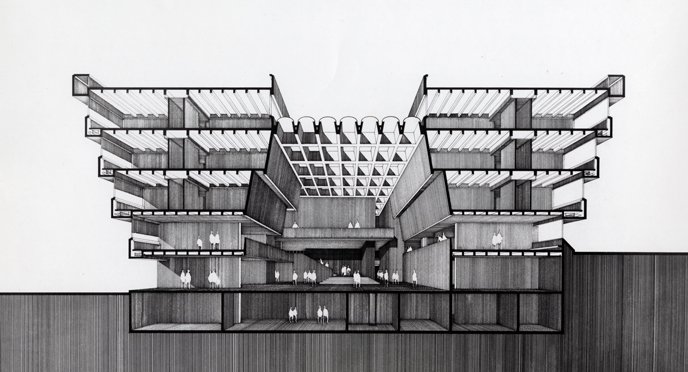Location: Scarborough, Toronto, Ontario
Date of Completion: 1964
Architect: John Andrews Architect and Page and Steele
Nominated by: Vijay Thanigasalam, MPP (Scarborough–Rouge Park)
“
[John Andrews’ buildings] say something simply and easily understood about where you are and what you’re doing there.” - Earl Berger
Following the ebbs and flows of the river valley below, the Science and Humanities Wings of then Scarborough College (now the Andrews Building at the University of Toronto Scarborough) was a radical departure for campus architecture in Canada. It was shaped not by tradition and history, but by a thorough understanding of functional needs, an acute awareness of its location and – most importantly – a sincere empathy for its users.

The Andrews Building, Science Wing exterior, as seen from the valley.
Photo Credit: University of Toronto Scarborough Library, UTSC Archives Legacy Collection, Photographs - Box 1 (File 3).
Architecture, Landscape and Urbanism
While its dramatic and sculptural concrete shapes and forms are perhaps the most well-known (and photographed!) characteristics of this building, it is its deep connection to nature and site that is most often cited by those who frequent it on a daily basis.

Site Model of the original proposal. Note how the building was meant to continue along the ridge.
Image Credit: University of Toronto Scarborough Library, UTSC Archives Legacy Collection, Photographs - Box 3 (File 9).
The building is carefully positioned on the edge of a glacial ravine overlooking Highland Creek and its surrounding forest – a “rock-like extension of the escarpment upon which it rests .” Much like the glacial ravine it oversees, the building has been shaped by the elements – a mostly windowless wall of lecture halls protects the northern windswept face of the Humanities Wing while tiered offices on the south face provide views of the valley, each level of offices providing solar protection to the one below.

From left to right: Landscape Architect Michael Hough, Architect John Andrews and Urban Planner Michael Hugo Brunt, gathered around a model for Scarborough College.
Image Credit: University of Toronto Scarborough Library, UTSC Archives Legacy Collection, Photographs - Box 4 (File 8).
This deep connection between building and site is not by accident – the design team composed of an architect (John Andrews), a landscape architect (Michael Hough) and an urban designer (Michael Hugo Brunt) worked collaboratively to ensure the full integration of building with landscape.
A New Architecture for a New University
Until the Andrews Building, many of Canada’s post-secondary institutions were built following time-honoured building and campus layouts – the most ubiquitous of these being courtyard buildings that harken back to Oxford and Cambridge University and find their origin in the medieval cloister.
The Andrews Building broke free from that tradition, taking its design cues not from history and tradition but from a thorough understanding of the needs and goals of the university as well as a sincere empathy for its users.

Perspectival Section through the administrative heart of the Andrews Building - at its centre is the Meeting Place.
Image Credit: University of Toronto Scarborough Library, UTSC Archives Legacy Collection, Photographs - Box 1 (File 3).
Its shape – a singular, winding mega-structure – is to be thought of as a “microcosm of a small town” – with the classrooms, offices and labs arranged around central “internal streets” that meet at the aptly named “Meeting Place,” the town square of the college.
This shape responded to two distinct ambitions. First, the layout brings together into one structure all of the distinct disciplines of the college, with internal streets and spaces that provide opportunities for cross-pollination and collaboration. Second, the designers expressed profound empathy with the students who “would spend five or six months… stumbling through wind, rain, sleet and snow, from building to building, fumbling with coats and galoshes, getting wet, cold and ill.” This design was therefore as pragmatic as it was aspirational, keeping students dry while promoting collaboration.
This post forms part of our World Architecture Day Queen’s Park Picks 2018 series in which we asked Ontario’s Members of Provincial Parliament to nominate a prominent building, past or present, in their riding for a chance to learn more about it. Check out the rest of the series to learn more about great buildings across the province!
The OAA would like to thank the University of Toronto Scarborough Archives, the University of Toronto Archives, and IBI Group for the information, images and drawings that made this blOAAg post possible.
Sources
Frampton, Kenneth. “Scarborough College” in
Architectural Design, April 1967.
Emanuel, Muriel and Dennis Sharp. 1980.
Contemporary Architects. New York: St. Martin's Press, p.35.
Seaman, Heather. University of Toronto Scarborough in
Structures.
McHugh, Patricia and Alex Bozikovic.
Toronto Architecture: A City Guide. McClelland & Stewart, 2017. Print.
Walker, Paul. “Reassessing John Andrews’ Architecture: Harvard Connections” in Proceedings of the Society of Architectural Historians, Australian and New Zealand: 30, Open, edited by Alexandra Brown and Andrew Leach. 2013, vol2. P611-622 Accessed electronically:
https://www.griffith.edu.au/__data/assets/pdf_file/0033/349746/R04_01_Walker_Reassessing-John-Andrews-Architecture.pdf